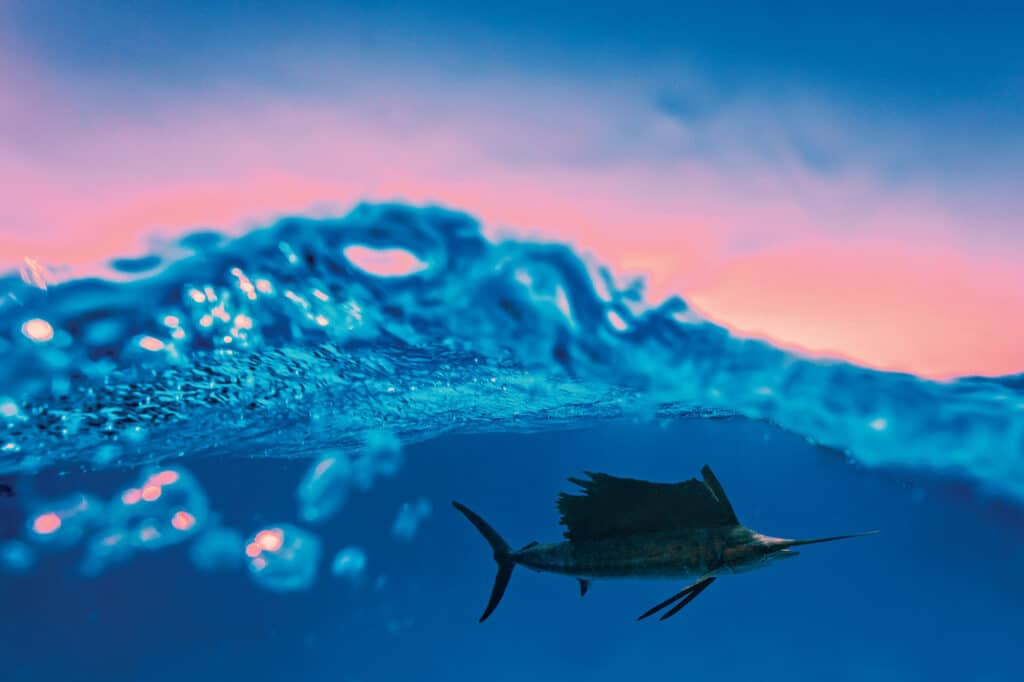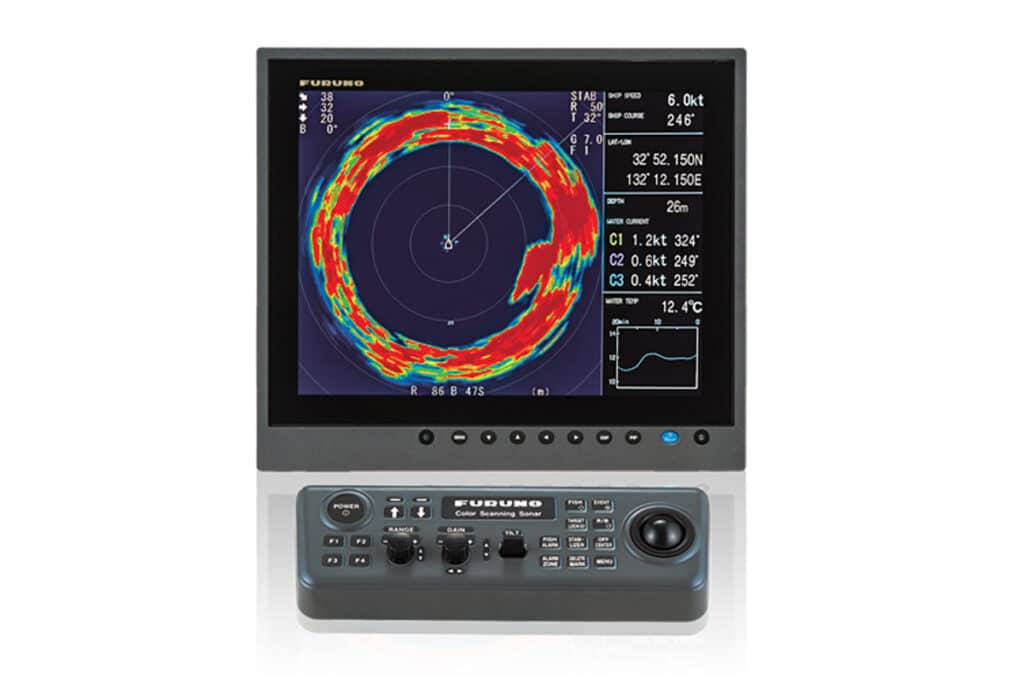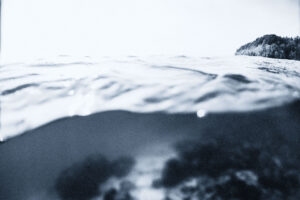
Capt. John Adams admits he wasn’t tuned in to what Furuno’s CSH-8L Mark-2 Full-Circle Scanning Sonar could do when it was first fitted aboard Griffin, the 65-foot Rybovich he runs out of the Palm Beach, Florida, area. His level of understanding changed as soon as the lines hit the water. “We caught three blue marlin and a sailfish that day,” he says. “Without a doubt, we wouldn’t have seen these targets without it.”
Adams compares trolling with standard sonar transducers to mowing an expansive lawn with a 30-inch push mower. By comparison, searching with Furuno’s 8L is akin to riding a Dixie Chopper. “Nothing really gets by you,” he says, adding that he’s won tournament money because of the Furuno system.
While sonar is commonly employed as a noun, it’s actually an acronym for “sound navigation and ranging.” The technology was developed in the early 20th century and was initially used to hunt submarines in both world wars. Omnidirectional sonar, which transmits acoustic energy simultaneously in a 360-degree pattern from the system’s transducer, has existed for decades. Furuno’s 8L was introduced in 2016, but recent years have seen sales increase, and it can now fit on smaller vessels too. The result is that more anglers have 8Ls to see 360 degrees around their boats’ hulls and out to 5,000 feet. The system can also be used for peering forward.
An 8L installation consists of a processor, a transceiver, a transducer, a control unit, a hull unit and cabling. Imagery can be displayed on a dedicated monitor or a networked Furuno TZtouch2 or TZtouch3 multifunction display. Owners can add items, including a loudspeaker, remote control or motion sensor, to simplify operations and increase system performance. The Furuno-built equipment retails at an $80,000 base price, but owners should expect an additional $30,000 to $50,000 for installation.
Like fish finders that use hull-mounted transducers, the 8L’s transducer requires laminar water flow to operate. To achieve this, the system has a hull unit, which consists of a tube with a telescoping threaded inner shaft that measures 2½ to 3 inches in diameter. The hull unit is installed vertically, and the shaft lowers and retracts by 15.7 inches or 23.6 inches, model-depending. The shaft’s inboard end attaches to the system’s hoisting mechanism, while the transducer is fitted to the shaft’s outboard end. The transceiver mounts inside the hull near the hoist, while the processor, control unit and display are situated higher up the schematic food chain.

“The 8L has 420 sonar elements,” says Matt Wood, Furuno’s national sales manager, adding that the system’s fixed phased-array transducer is composed of individual piezoelectric elements arranged in a circular pattern to form a layer. “Each layer has 30 elements, and the array is 14 layers high. All 420 elements fire at the same time.”
The result is a pulse of acoustic energy that transmits at 85 kHz once every 0.54 seconds. “Imagine an adjustable flood flashlight with a piece of black electrical tape in the center,” Wood says. The 8L’s onscreen imagery resembles a ring with visual marks denoting targets. “There’s a mechanical blind spot—you’re not looking directly under the boat. You can see the bottom, but there’s always some angle of attack.”
Because of this, users commonly run an echo sounder in tandem with their 8Ls.
That said, the system’s processor and transceiver can yield some onscreen magic.
“Users can electronically steer the center of the beam from 0 degrees to 55 degrees downward tilt,” Wood says. While the transducer’s elements are fixed, and while all elements fire simultaneously, the processor and transceiver can electronically steer the beam by rendering an onscreen video image that places greater value on some returns than others. This function, Wood says, is especially important for locating swordfish: “You can see, lock and track individual billfish.”
This same beam-steering capability allows mariners to peer in front of their vessel. The 5,000-foot range translates to three minutes, 17 seconds of reaction time at 15 knots. “It’s possible to use the 8L for navigation,” Wood says, adding that users can concentrate on the plus or minus 45 degrees in front of their bow to spot objects or seafloor structure.
Following Wood’s flashlight analogy, the more one’s hand swings while walking with a flashlight, the more the light jumps. The same holds for vessel motion and the 8L’s transmitted acoustic energy. While customers can spec a mechanical motion sensor that stabilizes the 8L’s video imagery along either its pitch or roll axis, “there’s no multi-axis stabilization—yet,” Wood says.
While the 8L creates a massive amount of sonar imagery that it displays in 16 onscreen colors, Wood suggests that operators limit boat speed to 10 to 15 knots when searching an area, and drop to 2 to 8 knots once gear is deployed. The 8L is rated to 18 knots, and Wood advises that mariners risk bending the telescopic shaft—due to accumulated hydrostatic pressure—if they go faster. One option, he says, is to network the 8L with the GPS and set it to retract automatically at certain speeds. Wood prefers to shed the transducer once he hooks up. While this means an initial 15 to 18 seconds of limbo as the transducer retracts, it ensures unrestricted maneuverability.
Given their high equipment and installation costs, 8Ls were initially found aboard large sport-fishing rides, but Wood says this has been changing. “There’s a desire to get more technology into smaller boats,” he says, pointing to 40-footers from Freeman Boatworks and Valhalla that carry 8Ls. While vessel motion can be an issue, well-equipped owners have been using gyrostabilizers. “We’re an ancillary beneficiary of Seakeeper,” Wood jokes.
Irrespective of waterline, Wood is clear that the 8L is for serious anglers: “Roughly 90 percent of our customers are professional captains—either captain-owners or captains for competitive owners.”
So, if you’re interested in upping your fish-hunting game, and you aren’t afraid of writing checks or tackling serious installation work, the Furuno 8L could be the next angling-arsenal upgrade.
Artistic Interpretations
Like analog radar, the 8L requires some know-how to read its onscreen imagery properly. Furuno offers an on-water training seminar, and most people understand how to use the system after 12 to 24 hours of hands-on use. “It’s about pushing buttons and scope time,” says Furuno’s Matt Wood.








